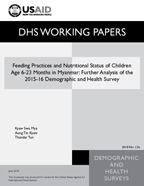
Abstract:
Nutritional deficiencies are a major problem
among developing countries such as Myanmar.
They can occur in all age groups, but the
impact is more severe among children age 6-23
months as this period is critical for child
development, and irreversible damage can
occur due to consequences of nutritional
deficiencies. Proper infant and young child
feeding (IYCF) practices are pivotal to
tackle nutritional problems and to prevent
irreversible consequences among children. To
assess the current feeding practices among
children age 6-23 months and associations
with their nutritional status, we conducted a
secondary data analysis using the 2015-16
Myanmar Demographic and Health Survey.
A total of 1,222 children age 6-23 months
were included in this analysis. Twenty
percent of children were stunted and 43% were
moderately anemic. Regarding IYCF practices,
only 16% of children received a minimum
acceptable diet, 25% received diverse food
groups, 58% were fed with minimum meal
frequency, 85% currently breastfed, and 59%
consumed iron-rich foods. Breastfeeding
reduced the odds of being stunted. By
background characteristics, male sex,
perceived small birth size, children of short
stature, and children of working mother were
significant predictors of stunting. Iron-rich
food consumption was inversely associated
with moderate anemia. Among covariates, male
sex and maternal anemia were also significant
predictors of moderate anemia among children
age 6-23 months.
The study concluded that stunting and anemia
among young children in Myanmar are major
public health challenges that need urgent
action. Children should be fed with diverse
food groups including iron-rich foods
according to the World Health Organization
(WHO) complementary feeding guidelines. While
further prospective research is needed to
determine the effect of feeding practice on
linear growth, interventions such as iron
supplementation, deworming, and nutritional
education programs could help prevent
stunting and childhood anemia and might
reduce their prevalence in Myanmar.
 Feeding Practices and Nutritional Status of Children Age 6-23 Months in Myanmar: Further Analysis of the 2015-16 Demographic and Health Survey (PDF, 1152K)
Feeding Practices and Nutritional Status of Children Age 6-23 Months in Myanmar: Further Analysis of the 2015-16 Demographic and Health Survey (PDF, 1152K)
